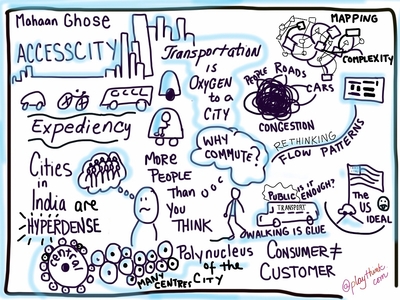ACCESSCITY – A systems enquiry & response on urban transport in Indian megacities
Ghose, Mahaan and Nahar, Praveen ACCESSCITY – A systems enquiry & response on urban transport in Indian megacities. In: Proceedings of RSD3, Third Symposium of Relating Systems Thinking to Design, 15-17 Oct 2014, Oslo, Norway.
Preview |
Text
Ghose _AccessCity_WorkingPaper_2014.pdf Download (3MB) | Preview |
![Ghose_MindMap_2014.jpg [thumbnail of Ghose_MindMap_2014.jpg]](https://openresearch.ocadu.ca/2102/2.hassmallThumbnailVersion/Ghose_MindMap_2014.jpg)  Preview |
Image
Ghose_MindMap_2014.jpg Download (509kB) | Preview |
Abstract
ACCESSCITY is based on a core hypothesis — as commute-durations keep increasing, there will be a crisis soon; where an individual will be commuting for 6-8 hrs, and will only be left with time to work, eat, & sleep, but nothing else. Milton Friedman explains “…There is enormous inertia – a tyranny of the status quo – in private & especially governmental arrangements. Only a crisis – actual or perceived – (can) produce real changes.” This crisis: CONGESTION, is not an uncertain problem that we may face in the future, but is affecting us today, growing disruptively. This is urgent & important.
It began with a simple question: What is the utility of a city? Mumbai Metropolitan has nearly equal population as the whole of Australia – what attracts people to cluster so closely? A city offers a citizen access to a social-life, job opportunities, healthcare, service & educational options, shopping & recreational facilities, etc. On the other end: the same city also makes this particular individual accessible to all the other citizens, job market, service market, real estate industry, healthcare & educational institutions, etc. This MUTUAL ACCESSIBILITY, is the core utility of a city. And denser the cluster, the more attractive it becomes. Lets bring another parameter: TIMING. History has lead us to specific activity timing (like office hours) – which clusters us even closer, in extreme densities. These hyper-clusters mostly take place in small areas, exponentially increasing accessibility. This high population flow through the limited street-network consequently leads us to our primary concern here, CONGESTION. Congestion is a very useless and ineffective TIME-TAX, that it is paid to no one, and no one benefits from it. Delhi NCR supposedly looses 14,000,000 man-hours/day due to congestion. The COMPLEXITY of the situation is more grave. Teilhard de Chardin elucidates, “…(Complexity depends) not only on the number and diversity of the elements included in each case, but at least as much on the number & correlative variety of the links formed between these elements.” So, we’re not dealing with just the number of vehicles, but the variety of relationships. When I was looking for a metaphor – the human-body fitted appropriately. A megacity’s transport-system is compared to the body’s circulatory-system – both the systems are indispensable for their meta systems’ survival.
| Item Type: | Conference/Workshop Item (Paper) |
|---|---|
| Divisions: | Faculty of Design |
| Date Deposited: | 21 Nov 2017 16:36 |
| Last Modified: | 20 Dec 2021 18:31 |
| URI: | https://openresearch.ocadu.ca/id/eprint/2102 |
Actions (login required)
 |
Edit View |

 Lists
Lists Lists
Lists